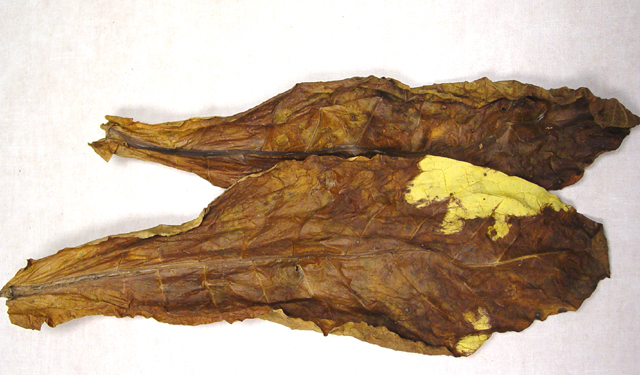AGRONOMY FACT SHEET TOB-1-04
![]()
Delayed
Curing Spot
By Gary Palmer
and Bob Pearce, Tobacco Specialist,
 Crops with high nitrogen fertility are expected to have more of a problem with
this than those receiving an optimum amount.
The last two years were characterized by wet seasons with plenty of
rainfall prior to harvest. While
some would think that a wet season would deplete nitrogen, many producers have
applied excessive amounts initially so that nitrogen that is lost is not much
of a factor. Tobacco took up
extra water and nitrogen after topping in both years which has undoubtedly
contributed to this phenomenon. A
drier curing season is not necessarily the answer, since most areas were
somewhat dry to very dry in September this year.
Crops with high nitrogen fertility are expected to have more of a problem with
this than those receiving an optimum amount.
The last two years were characterized by wet seasons with plenty of
rainfall prior to harvest. While
some would think that a wet season would deplete nitrogen, many producers have
applied excessive amounts initially so that nitrogen that is lost is not much
of a factor. Tobacco took up
extra water and nitrogen after topping in both years which has undoubtedly
contributed to this phenomenon. A
drier curing season is not necessarily the answer, since most areas were
somewhat dry to very dry in September this year.
Depending on when nitrogen uptake was most pronounced, leaves at different stalk positions can show these symptoms and in some cases the entire stalk will show the yellow fleshy spots. Leaves with a yellow fleshy spot can be thrown out at stripping if there are not too many of them; however that is not an option for those with a high percentage of leaves that are affected. Prospects for this tobacco are not good with yellow color often remaining even after the tobacco is completely cured. Leaves with uneven color should be baled separately from normally cured tobacco to avoid a grade reduction on the whole lot. Affected leaves can be tied into loose hands placed over a stick and hung back in the barn to cycle in and out of order. This process may lessen the color difference, but not totally eliminate it, and it will take some time.
To reduce this problem in the future care must be taken to minimize all possible factors, but weather cannot be changed. That leaves fertilization and variety selection as the only recourse. Although it is not totally understood how fertilization may contribute to this curing problem, it is still wise not to over fertilize the crop. Switching away from TN 86 or other varieties prone to this condition may help if this has been a reoccurring problem, but may not totally eliminate a reoccurrence. When this problem is observed patience is the key as these crops will take extra time for a complete cured.
![]()